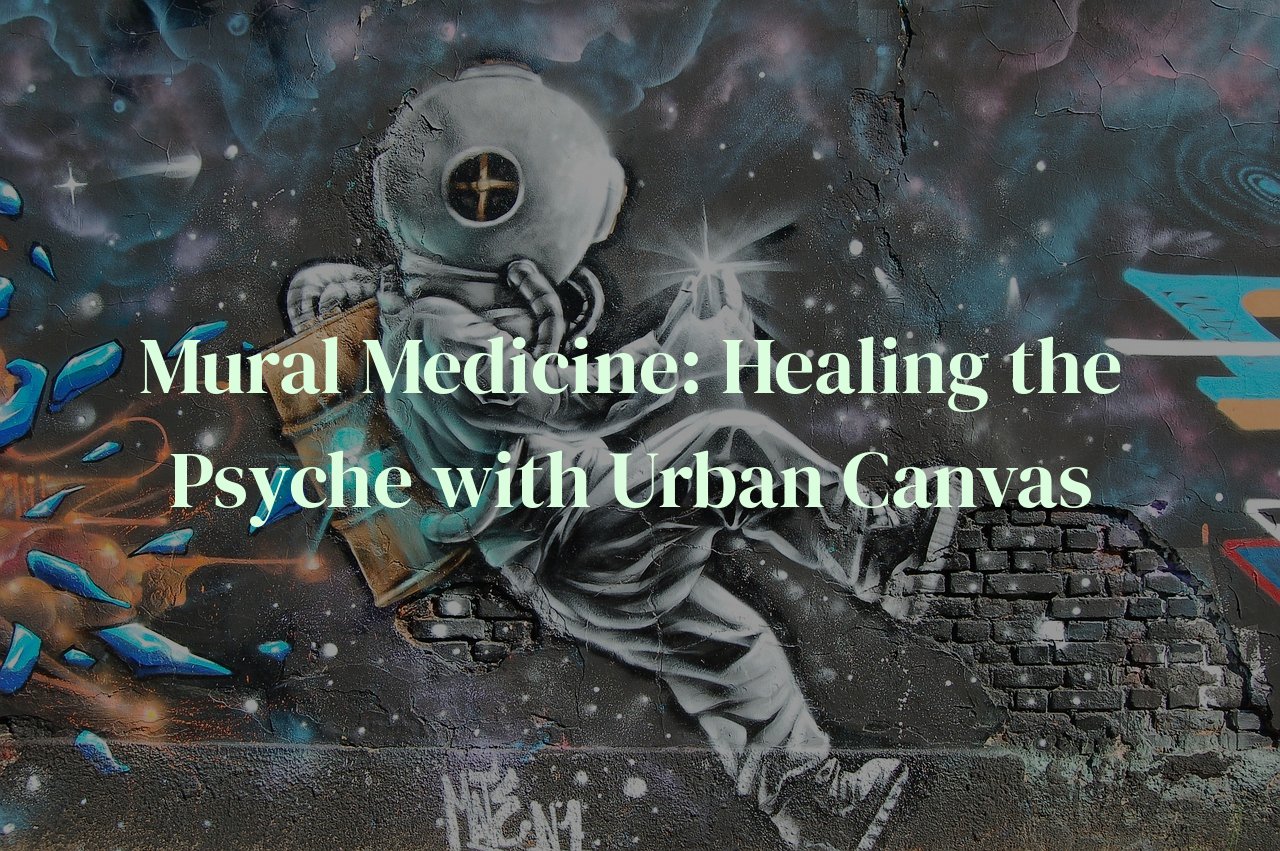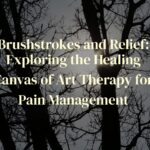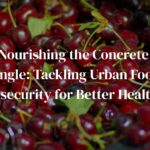
Intricately weaving the vibrancy of street art with the tapestry of community health, this post invites you on a journey through an unconventional healing landscape. Here, concrete becomes canvas and aerosol, a balm for the soul. Beyond mere aesthetic delight, we delve into how murals and graffiti, rooted in self-expression, are being leveraged to foster mental wellness and communal harmony. This exploration will unearth the symbiotic relationship between urban street art and the psychological serenity of its observers. Discover not only a novel perspective on mental health advocacy but also practical insights into how street art initiatives can serve as a catalyst for communal well-being.
Table of Contents
Brushstrokes of Consciousness: Street Art as a Dialogue on Mental Health
The visceral connection between urban street art and the community’s mental health is remarkable, and its impact runs deep, creating a unique form of dialogue that resonates with the collective psyche. In the effervescent city streets, the murals narrate stories that often remain untold, bringing to the forefront the intricate conversations on mental wellness. As I weave through these painted narratives, I sense a profound shift—a heightened awareness about mental health issues embedded within the color and contours of each piece.
One artwork, a voluminous depiction of clasped hands breaking chains, speaks volumes about the struggles with anxiety and the power in unity and support. The potency of this image lies in its ability to prompt passersby to pause and consider the bonds of mental entrapment and the liberation found in community solidarity. Art, in this form, becomes more than a visual stimulant; it’s a catalyst for dialogue and introspection about mental health.
Another mural, a kaleidoscopic vision with eyes peering through swirls of blue and green, opens a window into the soul’s complex tapestry. This vivid splash of colors beckons the community to acknowledge the multitude of emotions that individuals battle silently. The eyes, a window to the internal storm, create an intimate connection with the observer, inviting empathy and reflection. As an advocate for mental health, I am consistently moved by these art pieces, each acting as a powerful communique urging us to dissolve the stigma and wear our vulnerabilities as badges of honor.
Street art, inherently public and democratic, cultivates an open space for mental health discourse. In the heart of the urban jungle, where isolation can hold sway amidst the crowd, these murals become shared emotional landscapes. They serve as public forums where individuals can confront and converse about their journey through mental health, encouraged by the strokes of a street artist’s brush—a communal psychotherapy, etched in paint and passion.
This visual symphony of street art does not merely exist for aesthetic indulgence; it stands as a sentinel for social change. It propagates the vital message that mental health is not a solitary fight; that within the colorful arrays and bold lines etched across our urban canvases lies a universal whisper, an ongoing dialogue seeking to heal, empower, and unite.
Colorful Catharsis: A Palette of Emotional Expression and Relief
The concept of catharsis has been intertwined with artistic expression for millennia, yet it is within the vibrant swaths of street art murals that we witness a contemporary translation of this emotional release. My own exploration of urban murals has time and again revealed to me the deep reservoirs of personal expression etched into every stroke and hue, turning cold cityscapes into sprawling canvases of collective emotional ventilation. The idea here is not just to decorate but to communicate – the mural stands as a testament to struggles faced, battles fought, and sometimes, simply a declaration that ‘I feel, therefore I am.’
On a stroll through the heart of the city, I’ve seen murals that depict towering figures breaking through chains, abstract spirals delving into the psyche, and faces rendered with such raw emotion they seem to peep into your soul. Each piece tells a story, a drop in the ocean of communal consciousness that echoes the sentiment: You are not alone. These artworks serve as public diaries, where the anonymous and the famed pour out their innermost thoughts without restraint. In the palette of a street artist, each color represents a spectrum of emotions – from the fiery reds of anger and passion to the somber blues of melancholy and introspection.
The mural becomes a node of connection, a place where onlookers are confronted with the reality that their private battles are shared. Through these encounters, I have felt a visceral sense of relief, a silent acknowledgement that my own internal tumult is part of a larger narrative. The interplay of colors, the juxtaposition of forms – all work to create a visual symphony that can soothe the disturbed mind and offer respite from the relentless pace of urban life.
The sheer size and public nature of murals mean that these works do not shy away from commanding attention and fostering a dialogue. In areas marred by socio-economic downturns, I’ve watched murals become a rallying point for community solidarity, with locals taking pride in participating in or even initiating such projects. It’s a form of art therapy on a communal scale, addressing not just individual needs but the mental health of a community. In this way, murals can paint a picture of hope, an expansive embrace that encourages passersby to shed their emotional load, if only for a moment.
As a blogger, I have come to recognize the profound impact that a single piece of art in public space can have on individual wellness. Recounting personal anecdotes from those who’ve found solace in these urban masterpieces has shown me that spray paint, when guided by the empathetic hand of an artist, becomes a tool for healing. It is here, on the streets that we all share, that art becomes a bridge over troubled waters, extending an invitation to pause, reflect, and quite possibly, heal.
The Alchemy of Aesthetics: How Murals Transform Urban Strain into Solace
The alchemy of public murals in transforming the gritty urban landscape into a soothing oasis is a testament to the power of aesthetics. From my experience strolling through the once dull alleyways now animated with vibrant colors, it’s clear that murals do more than adorn walls; they heal souls. The transformation is subtle yet profound, as the bleak concrete that once absorbed the city’s stress now radiates tranquility.
Engaging with these large-scale artworks, I have witnessed the weariness in people’s eyes ease into thoughtful contemplation. Here lies the crux of aesthetic alchemy: the transfiguration of public spaces transcends mere physical beauty, fostering emotional havens in place of urban strain. Murals become not just visual escapades but also tactile experiences that invite residents to reach out and trace the stories painted on their very streets.
As I reflect on the potency of each brushstroke, I recall a mural that depicted a serene landscape amidst a hectic intersection. The effect was magnetic, drawing a crowd that momentarily disconnected from the horns and sirens to immerse in pictorial quietude. At this junction of art and life, murals became instruments of mental reprieve, a therapy embedded in the very architecture of our daily commute.
In the delicate dance of light and color, muralists re-enchant urban territories, imbuing them with imaginative energy that opposes the monochrome of city strife. Each artwork, a crafted narrative, taps into the collective yearning for gentleness in a hardened environment. Murals, thus, act as visual hymns, chanting an invitation to find solace in shared spaces, reminding us that beauty is a conduit for peace amidst chaos.
In the realm of mural medicine, the transformation is both personal and shared, a duality that strikes at the heart of community mental wellness. From an intimate conversation sparked by a poignant piece to an impromptu gathering of strangers drawn by a mural’s allure, the alchemy of aesthetics proves itself as an antidote to urban fatigue, turning walls into wellsprings of solace.
Community Canvases: Creating Collective Resilience through Public Art
Imagine walking through a once colorless alley, now pulsing with the vibrancy of a mural that tells the story of a community’s resilience. That’s the power of public art as a canvas for collective well-being, a concept I’ve seen come to life in neighborhoods eager to transform shared spaces into healing landscapes.
In one community, a massive wall transformed into a tapestry of faces representing cultural diversity, became a daily reminder of shared humanity and strength. Each brushstroke added to the mural by local artists and volunteers embodied the narrative of unification and solace amidst the city’s cacophony.
Another instance saw a distressed neighborhood, plagued by negative stereotypes, reclaim their identity through a series of vibrant murals. These public artworks became a beacon of pride and a catalyst for positive mental health, countering pervasive social stigma with bold, uplifting imagery and enabling residents to experience their home through a refreshed, empowering lens.
Public art initiatives like these not only beautify spaces but also foster a sense of communal ownership and responsibility. Through creative workshops and inclusive design processes, the mural-making becomes an act of collective therapy. Each splash of color contributes to a larger representation of the community’s aspirations, struggles, and triumphs.
Once, at a community gathering, a local expressed how the mural outside her window interconnected with her inner healing journey, saying, ‘Every morning, it greets me with its colors. It reminds me that my own healing is a mosaic of different moments, emotions, and people.’ This personal anecdote underscores the intimate connection between public art and individual well-being.
Indeed, community murals are not just art installations for aesthetic pleasure; they are pulsating hearts within a neighborhood. They offer a constant, open invitation to reflect, connect, and heal. In this way, a wall becomes more than a mere boundary; it becomes a bridge, a place of gathering, of storytelling and quiet reflection—a resilient beat in the larger rhythm of urban life.
Spray Paint and Serenity: Personal Anecdotes of Artistic Influence on Well-being
As we navigate through the bustling alleys and streets humming with the cacophony of urban life, we stumble upon a distinct element that brings a moment of respite: the mural. These aren’t just splashes of color on a lifeless wall but are resonant narratives that speak to the individual experiences we each harbor. It’s the organic tales behind this street art that divulge the potency it possesses in influencing mental well-being.
I recall a particular mural that stretched across the side of an aging building like a canvas of shared human experience. It depicted a visage fractured, yet held together with vibrant threads, a metaphor for the human condition’s intrinsic resilience. This particular piece struck a chord for me during a time where I felt fragmented by personal trials. I remember standing before it, the coolness of the shadows mingling with bursts of sunlight that perfectly framed the mural, casting a warmth that seemed to pierce through my turmoil.
The impact of such art became tangible through conversations with onlookers, who like me had found a silent sanctuary in its presence. One individual, a young artist struggling with anxiety, shared how the mural’s vivid colors acted as a non-verbal medium for expressing emotions that words failed to capture. Each time they visited the mural, they described feeling a sense of release, as if the wall absorbed some of their inner chaos, offering back serenity.
Another encounter involved a group of community members who spoke of the mural’s role in brightening their everyday routine. One shared that the mural served as a visual reminder to pause and reflect, providing a break from the relentless pace of city life. The image of a fractured, yet seamless face reminded him that brokenness can transform into a source of strength, fostering a communal sense of hope and resilience.
These murals, crafted from spray paint and passion, become much more than an aesthetic accompaniment to urban architecture. They offer a silent solidarity, speaking to each passerby in a language unique to their circumstance. As a blogger deeply embedded in the exploration of the intersection between art and mental wellness, I’ve borne witness to these murals acting as unspoken dialogue partners that assist in processing complex feelings, healing unseen wounds, and fostering an environment that champions emotional well-being.
Conclusion
As we step back to admire the intersection of artful streetscapes and the mosaic of our minds, it becomes evident that street art offers more than splashes of color in our urban jungles. It stands as a testament to humanity’s innate need for beauty, expression, and connection, wielding the power to foster a collective breath of mental clarity and resilience. This post has journeyed through the heart of urban artistry, highlighting how each mural holds the potential to be a cornerstone in the crusade for mental wellness. In recognizing the silent yet profound impact of street art on societal mental health, we uncover a compelling narrative where every wall has the chance to echo solidarity, comfort, and inspiration in the pursuit of community-wide healing.



